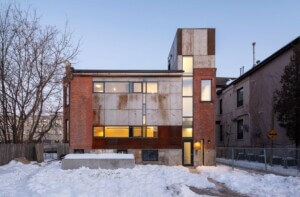The Congress for the New Urbanism has released their annual list of Freeways Without Futures. The organization selected the top 10 urban American (and one Canadian) highways most in need of removal. The final list was culled from nominations from more than 50 cities. Criteria for inclusion included age of the freeway, the potential that removal would have to positively effect the areas where the roadways are currently situated, and the amount of momentum to realize such removals. Additionally the CNU highlighted campaigns in Dallas, the Bronx, Pasadena, Buffalo, and Niagra Falls, that are taking significant steps towards removing freeways (some of which have been included in past lists) as illustrations of broader institutional and political shifts on urban infrastructural thinking.
I-10/Claiborne Overpass – New Orleans
The already aging Interstate 10 was heavily damaged in 2005 during Hurricane Katrina. The Unified New Orleans Plan (UNOP) suggested that the removal of the elevated portion of the highway would allow for the reclamation of 35 to 40 city blocks and 20 to 25 blocks of open space. With the help of public engagement Livable Claiborne Communities outlined a plan for a similar removal that would improve living conditions in the neighborhood in the immediate vicinity of the expressway.
I-81 – Syracuse
This road, including an elevated portion that runs through downtown Syracuse, was built in the 60’s. Advocates for the transformation of the most urban portion of the freeway could be replaced by a boulevard that would connect neighborhoods, inject economic activity into the area, and be cheaper to maintain. Numerous local politicians have spoken in favor of such a plan and the Syracuse Metropolitan Transportation Council and the New York State Department of Transportation (NYSDOT) co-led the I-81 Challenge to examine traffic patterns and alternatives to the current state of the highway.
Gardiner Expressway – Toronto
Unpopular with local citizens, the overworked Expressway requires more than $10 million annually in repairs. Recently, the City of Toronto and WATERFRONToronto finished work on the Gardiner Expressway & Lake Shore Boulevard Reconfiguration Environmental Assessment & Urban Design Study which will dictate the future of the portion of the Gardiner overlooking Lake Ontario.
Route 5/Skyway – Buffalo
The Skyway Bridge and Route 5 mar public views of the Buffalo River, diminish land values, and create a web of confusing traffic patterns predicated on inefficient one-way streets. The Department of Transportation rates the Skyway bridge as “fracture critical” while the Federal Highway Administration classifies the bridge as “functionally obsolete.” It is likely to cost more than $50 million to maintain over the next two decades.
Inner Loop – Rochester
The Loop was built for the city Rochester once was, rather than the shrunken metropolis that stands today. For this reason much of the beltway carries traffic that could easily be carried by a urban avenue. Furthermore it constricts the downtown area, inhibiting development and isolating adjacent neighborhoods. In 2012 the city was awarded a USDOT TIGER grant to replace the eastern portion of the Loop with a two lane boulevard flanked by street parking.
I-70 – St. Louis
I-70 separates the city from the waterfront of the Mississippi River and Saarinen’s iconic arch. Calls for bridging this divide by converting the expressway into an urban boulevard have been long simmering. Park Over The Highway is a $380 million project for a park and pedestrian and bike path that leaps I-70 in connecting the city to the area abutting the river.
I-280 – San Francisco
Meant to be part of a larger web of freeways that was ultimately halted by mid-century protests, the removal of this highway stub would increase the land values of the area by $80 million according to a report by Fourth and King Street Railyards. Replacing the strip with a urban boulevard would open the area for further redevelopment and allow for greater fluidity between neighborhoods. The city’s Center for Architecture + Design has hosted a design competition for such a project.
I-375 – Detroit
This 1.06 mile strip served to divide portions of the city and contributed to the isolation and subsequent decay of once thriving black neighborhoods. Detroit’s drop in population has lead to a 13% decrease in usage since 2009. In December of 2013, Detroit’s Downtown Development Authority moved forward with alternative plans for the highway, with particular focus on converting the road into a more pedestrian-friendly thoroughfare.
Terminal Island Freeway – Long Beach
As it stands the freeway currently serves a mere 14,000 vehicles a day, numbers that could drop further if plans to expand the Intermodal Container Transfer Facility come to fruition, a development that would redirect significant freight traffic in the area. Local nonprofit urban design studio City Fabrick have spear-headed a movement to convert the road into a greenbelt that would act as a buffer between residential districts and industrial port infrastructure. In 2013 the plan was awarded a Caltrans grant.
Aetna Viaduct – Hartford
This 3/4 mile stretch of elevated expressway was completed in 1965. In running directly through downtown Hartford the Viaduct destroyed historic architecture, public spaces, and severed inter-community links once easily traversed by foot. Initially set for costly re-surfacing that would increase its lifespan by 20 years, new plans are being considered for the heavily-trafficked road. Hartford officials and Capitol Region Council of Governments (CRCOG) are currently considering plans to re-align nearby rail tracks that would open 15-20 acres of nearby land for redevelopment.










